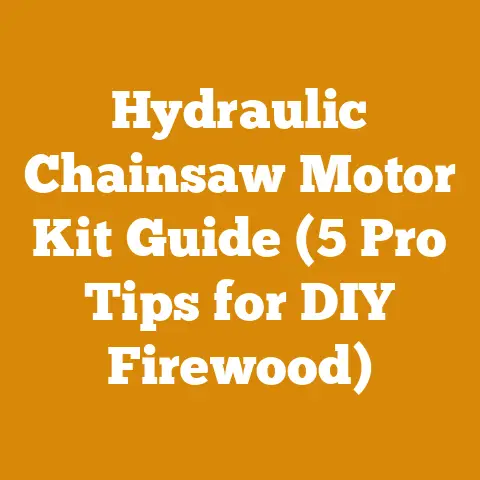Fuel Line Routing on Poulan Chainsaws (5 Expert Tips)
“Aha!” The frustration was palpable. I remember staring at a disassembled Poulan chainsaw, its fuel lines a tangled mess. I’d confidently taken it apart for what I thought would be a simple fuel filter change. Now? I was questioning my sanity. The original routing seemed like a cruel joke designed by a mischievous engineer. After hours of online searches and head-scratching, I finally cracked the code. That day, I vowed to create a clear, concise guide on Poulan chainsaw fuel line routing, so no one else would suffer my fate. This guide, built on experience and countless successful repairs, will give you the expert knowledge you need.
Fuel Line Routing on Poulan Chainsaws: 5 Expert Tips
Fuel line routing on Poulan chainsaws can seem daunting, but it doesn’t have to be. I’ve been working on these saws for years, and I’ve developed a system that works. In this guide, I’ll share my top five expert tips to help you navigate the fuel line maze with confidence. We’ll cover everything from identifying the correct lines to avoiding common mistakes.
1. Understanding the Poulan Fuel System: A Visual Guide
Before you even think about routing fuel lines, it’s crucial to understand the basic layout of a Poulan chainsaw’s fuel system. Many Poulan chainsaws use a similar 2-line fuel system. It’s important to understand which line goes where.
- Fuel Tank: This is where the gasoline and oil mixture is stored.
- Fuel Filter: Located inside the fuel tank, connected to one of the fuel lines. It filters out debris to prevent carburetor clogs.
- Fuel Lines: Typically two lines: one for fuel intake (with the filter) and one for fuel return.
- Carburetor: The heart of the engine, mixing fuel and air for combustion. It has two fuel line connection points.
- Primer Bulb: A small bulb that, when pressed, draws fuel from the tank to the carburetor, aiding in starting.
Identifying the Lines:
- Filtered Line (Intake): This line runs from the fuel filter inside the tank to the carburetor’s fuel inlet. It’s usually the longer of the two lines.
- Return Line: This line runs from the carburetor back to the fuel tank. It allows excess fuel to return to the tank, preventing flooding. It’s usually shorter.
I’ve found that sketching a quick diagram of the fuel system before disassembly can be a lifesaver. Label each line and connection point. Take pictures with your phone. Trust me, future you will be grateful.
Takeaway: Understanding the fuel system layout is fundamental. Identify the fuel lines and their connections before you start working.
2. The Cardinal Rule: Document Before Disassembly
This is the golden rule of chainsaw repair, and it applies especially to fuel lines. Before you even think about pulling those lines off, document everything.
Methods for Documentation:
- High-Resolution Photos: Use your smartphone or a digital camera to take detailed pictures of the fuel line routing from multiple angles. Focus on the connection points at the carburetor and the fuel tank.
- Video Recording: Record a short video as you disconnect the fuel lines. Narrate what you’re doing and where each line connects.
- Sketching a Diagram: Create a hand-drawn diagram of the fuel system, labeling each fuel line and connection point. Use different colors for each line to avoid confusion.
Why is this so important?
Memory is unreliable. Even if you think you’ll remember the routing, the chances are high that you’ll forget something. Photos and diagrams provide a visual reference that you can consult at any time during reassembly. I can’t tell you how many times I’ve relied on a quick snapshot to avoid a major headache.
My Personal Experience:
I once worked on a Poulan Wild Thing where the previous owner had completely butchered the fuel line routing. There were extra lines, lines connected to the wrong ports, and even a line that was simply dangling in the engine compartment. Without the “before” pictures I took, I would have been completely lost.
Takeaway: Document the fuel line routing before you disassemble anything. This simple step can save you hours of frustration.
3. Choosing the Right Fuel Line: Size and Material Matter
Not all fuel lines are created equal. Using the wrong type or size of fuel line can lead to leaks, fuel starvation, and engine damage.
Fuel Line Materials:
- Tygon: This is a popular choice for chainsaw fuel lines due to its resistance to gasoline, oil, and other chemicals. It’s flexible and durable, and it can withstand high temperatures. I generally prefer Tygon.
- Viton: Another good option for fuel lines, offering excellent chemical resistance. Viton is often slightly more expensive than Tygon.
- Rubber: Avoid using standard rubber fuel lines, as they can degrade quickly when exposed to gasoline.
Fuel Line Sizes:
Poulan chainsaws typically use fuel lines with an inner diameter (ID) of 1/8 inch (3.175 mm) or 3/32 inch (2.38 mm). It’s crucial to use the correct size for a tight, leak-proof fit.
How to Determine the Correct Size:
- Consult the Owner’s Manual: The owner’s manual should specify the correct fuel line size for your specific Poulan chainsaw model.
- Measure the Old Fuel Line: If you have the old fuel lines, you can measure their inner diameter using calipers.
- Cross-Reference with Parts Diagrams: Online parts diagrams for your chainsaw model often list the fuel line size.
My Recommendation:
I always recommend using Tygon fuel line with the correct inner diameter. It’s a reliable and durable option that will provide years of service. I usually buy a roll of each size (1/8 inch and 3/32 inch) to have on hand.
Takeaway: Use the correct type and size of fuel line to ensure proper fuel delivery and prevent leaks. Tygon fuel line is generally a good choice.
4. Routing Techniques: Avoiding Kinks and Heat
Proper fuel line routing is essential for optimal engine performance and longevity. The goal is to ensure a smooth, unrestricted flow of fuel while protecting the lines from damage.
Key Considerations:
- Avoid Kinks: Kinks in the fuel lines restrict fuel flow and can cause the engine to stall or run poorly. Ensure that the lines are routed in a way that avoids sharp bends or twists.
- Protect from Heat: Fuel lines should be routed away from hot engine components, such as the muffler and cylinder. Excessive heat can cause the fuel lines to degrade and crack.
- Secure the Lines: Use zip ties or clamps to secure the fuel lines in place. This prevents them from rubbing against other parts of the engine, which can lead to wear and tear.
- Maintain Proper Length: Avoid using fuel lines that are too long or too short. Excessively long lines can create unnecessary resistance, while short lines can be strained and prone to cracking.
Specific Routing Tips:
- Fuel Filter Line: Route this line from the fuel tank to the carburetor, ensuring that it’s not pinched or kinked. Pay attention to the angle of entry into the tank.
- Return Line: Route this line from the carburetor back to the fuel tank, avoiding contact with hot engine parts. Make sure the line is securely attached to both the carburetor and the tank.
- Primer Bulb Line: If your chainsaw has a primer bulb, ensure that the lines connecting the bulb to the carburetor and fuel tank are properly routed and secured.
My Personal Tip:
I often use a small, flexible wire to guide the fuel lines through tight spaces. Simply attach the wire to the end of the fuel line and use it to pull the line through the desired path. This can be especially helpful when routing lines around the engine.
Takeaway: Route fuel lines carefully to avoid kinks, heat, and rubbing. Secure the lines with zip ties or clamps to prevent damage.
5. Troubleshooting Common Fuel Line Issues
Even with the best routing techniques, fuel line problems can still occur. Here are some common issues and how to troubleshoot them:
- Fuel Leaks: Fuel leaks are often caused by cracked or damaged fuel lines, loose connections, or improper fuel line size. Inspect the fuel lines for cracks or holes, and tighten any loose connections. Replace the fuel lines if necessary.
- Fuel Starvation: Fuel starvation can occur if the fuel lines are kinked, blocked, or disconnected. Check the fuel lines for obstructions, and ensure that they are properly connected to the carburetor and fuel tank.
- Hard Starting: Hard starting can be caused by a clogged fuel filter, a faulty primer bulb, or air leaks in the fuel lines. Replace the fuel filter, check the primer bulb for cracks or leaks, and inspect the fuel lines for damage.
- Engine Stalling: Engine stalling can be caused by a variety of fuel-related issues, including fuel starvation, fuel leaks, and a clogged carburetor. Start by checking the fuel lines for kinks or obstructions, and then inspect the carburetor for dirt or debris.
Troubleshooting Steps:
- Visual Inspection: Start by visually inspecting the fuel lines for cracks, leaks, or kinks.
- Fuel Filter Check: Remove the fuel filter from the tank and inspect it for clogs or damage. Replace the filter if necessary.
- Primer Bulb Test: Check the primer bulb for cracks or leaks. If the bulb is damaged, replace it.
- Carburetor Inspection: Inspect the carburetor for dirt or debris. Clean the carburetor if necessary.
- Fuel Line Replacement: If the fuel lines are cracked, damaged, or the wrong size, replace them with new lines.
My Troubleshooting Story:
I once had a Poulan chainsaw that would start but then immediately stall. I went through all the usual troubleshooting steps: I cleaned the carburetor, replaced the fuel filter, and checked the spark plug. Finally, I noticed a tiny crack in one of the fuel lines near the carburetor. The crack was so small that it was difficult to see, but it was enough to cause the engine to stall. Replacing the fuel line solved the problem.
Takeaway: Troubleshooting fuel line issues requires a systematic approach. Start with a visual inspection, and then work your way through the troubleshooting steps.
Bonus Tip: Fuel Line Installation Tool
Installing fuel lines, especially inside the fuel tank, can be tricky. A fuel line installation tool can make the job much easier. These tools typically consist of a long, flexible wire with a hook or barb on one end. You can use the tool to grab the fuel line and pull it through the tank opening. I find this tool invaluable for preventing frustration and saving time. You can also use a long hemostat or needle nose pliers.
Beyond the Basics: Advanced Fuel System Considerations
For those who want to delve deeper into Poulan chainsaw fuel systems, here are a few advanced considerations:
- Carburetor Tuning: After replacing the fuel lines, you may need to adjust the carburetor to ensure proper fuel mixture. Refer to your owner’s manual for instructions on carburetor tuning.
- Fuel Stabilizers: Adding a fuel stabilizer to your gasoline can help prevent fuel degradation and keep the fuel system clean. This is especially important if you store your chainsaw for extended periods. I use Stabil brand fuel stabilizer.
- Ethanol in Fuel: Ethanol can damage fuel lines and other engine components. Use fuel with a low ethanol content, or add a fuel treatment that protects against ethanol damage.
- Fuel Line Clamps: Consider using small fuel line clamps to secure the fuel lines to the carburetor and fuel tank. This can help prevent leaks and ensure a tight connection.
Maintaining Your Fuel System for Longevity
Regular maintenance is key to keeping your Poulan chainsaw’s fuel system in top condition. Here’s a maintenance schedule I recommend:
- Every Use: Check the fuel lines for cracks or leaks.
- Monthly: Inspect the fuel filter and clean or replace it if necessary.
- Annually: Replace the fuel lines, regardless of their condition.
- Before Storage: Drain the fuel tank or add a fuel stabilizer to the fuel.
Safety First: Handling Fuel Responsibly
Working with gasoline can be dangerous. Always take the following safety precautions:
- Work in a Well-Ventilated Area: Gasoline fumes can be harmful.
- Wear Safety Glasses: Protect your eyes from fuel splashes.
- Avoid Open Flames: Gasoline is highly flammable.
- Dispose of Used Fuel Properly: Do not pour used fuel down the drain or on the ground.
- Keep a Fire Extinguisher Nearby: In case of a fire, have a fire extinguisher readily available.
Conclusion: Mastering Poulan Chainsaw Fuel Line Routing
Fuel line routing on Poulan chainsaws doesn’t have to be a nightmare. By understanding the fuel system, documenting before disassembly, choosing the right fuel lines, using proper routing techniques, and troubleshooting common issues, you can confidently tackle this task. Remember to prioritize safety and perform regular maintenance to keep your chainsaw running smoothly. With these expert tips, you’ll be back to cutting wood in no time! Now, go forth and conquer those fuel lines! And remember, a little patience and a good diagram can go a long way.






